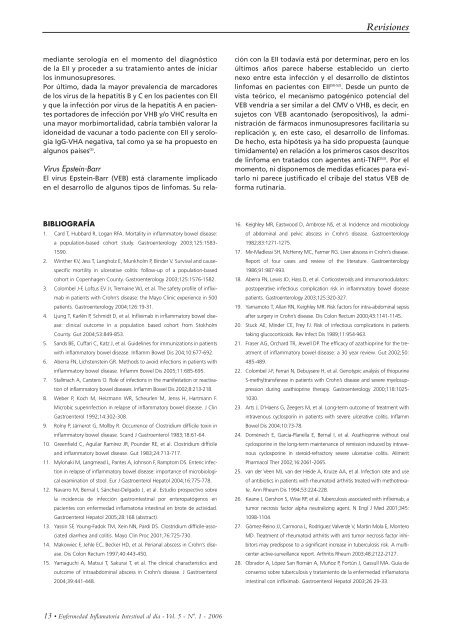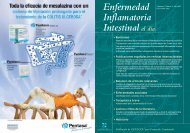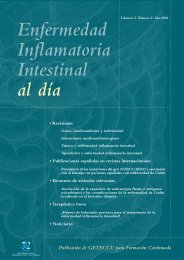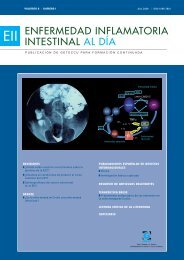Número 1 - EII al dÃa
Número 1 - EII al dÃa
Número 1 - EII al dÃa
Create successful ePaper yourself
Turn your PDF publications into a flip-book with our unique Google optimized e-Paper software.
Revisiones<br />
mediante serología en el momento del diagnóstico<br />
de la <strong>EII</strong> y proceder a su tratamiento antes de iniciar<br />
los inmunosupresores.<br />
Por último, dada la mayor prev<strong>al</strong>encia de marcadores<br />
de los virus de la hepatitis B y C en los pacientes con <strong>EII</strong><br />
y que la infección por virus de la hepatitis A en pacientes<br />
portadores de infección por VHB y/o VHC resulta en<br />
una mayor morbimort<strong>al</strong>idad, cabría también v<strong>al</strong>orar la<br />
idoneidad de vacunar a todo paciente con <strong>EII</strong> y serología<br />
IgG-VHA negativa, t<strong>al</strong> como ya se ha propuesto en<br />
<strong>al</strong>gunos países (5) .<br />
Virus Epstein-Barr<br />
El virus Epstein-Barr (VEB) está claramente implicado<br />
en el desarrollo de <strong>al</strong>gunos tipos de linfomas. Su relación<br />
con la <strong>EII</strong> todavía está por determinar, pero en los<br />
últimos años parece haberse establecido un cierto<br />
nexo entre esta infección y el desarrollo de distintos<br />
linfomas en pacientes con <strong>EII</strong> (50-52) . Desde un punto de<br />
vista teórico, el mecanismo patogénico potenci<strong>al</strong> del<br />
VEB vendría a ser similar a del CMV o VHB, es decir, en<br />
sujetos con VEB acantonado (seropositivos), la administración<br />
de fármacos inmunosupresores facilitaría su<br />
replicación y, en este caso, el desarrollo de linfomas.<br />
De hecho, esta hipótesis ya ha sido propuesta (aunque<br />
tímidamente) en relación a los primeros casos descritos<br />
de linfoma en tratados con agentes anti-TNF (53) . Por el<br />
momento, ni disponemos de medidas eficaces para evitarlo<br />
ni parece justificado el cribaje del status VEB de<br />
forma rutinaria.<br />
BIBLIOGRAFÍA<br />
1. Card T, Hubbard R, Logan RFA. Mort<strong>al</strong>ity in inflammatory bowel disease:<br />
a population-based cohort study. Gastroenterology 2003;125:1583-<br />
1590.<br />
2. Winther KV, Jess T, Langholz E, Munkholm P, Binder V. Surviv<strong>al</strong> and causespecific<br />
mortility in ulcerative colitis: follow-up of a population-based<br />
cohort in Copenhagen County. Gastroenterology 2003;125:1576-1582.<br />
3. Colombel J-F, Loftus EV Jr, Tremaine WJ, et <strong>al</strong>. The safety profile of infliximab<br />
in patients with Crohn’s disease: the Mayo Clinic experience in 500<br />
patients. Gastroenterology 2004;126:19-31.<br />
4. Ljung T, Karlén P, Schmidt D, et <strong>al</strong>. Infliximab in inflammatory bowel disease:<br />
clinic<strong>al</strong> outcome in a population based cohort from Stokholm<br />
County. Gut 2004;53:849-853.<br />
5. Sands BE, Cuffari C, Katz J, et <strong>al</strong>. Guidelines for immunizations in patients<br />
with inflammatory bowel disease. Inflamm Bowel Dis 204;10:677-692.<br />
6. Aberra FN, Lichstenstein GR. Methods to avoid infections in patients with<br />
inflammatory bowel disease. Inflamm Bowel Dis 2005;11:685-695.<br />
7. St<strong>al</strong>lmach A, Carstens O. Role of infections in the manifestation or reactivation<br />
of inflammatory bowel diseases. Inflamm Bowel Dis 2002;8:213-218.<br />
8. Weber P, Koch M, Heizmann WR, Scheurlen M, Jenss H, Hartmann F.<br />
Microbic superinfection in relapse of inflammatory bowel disease. J Clin<br />
Gastroenterol 1992;14:302-308.<br />
9. Rolny P, Järnerot G, Mollby R. Occurrence of Clostridium difficile toxin in<br />
inflammatory bowel disease. Scand J Gastroenterol 1983;18:61-64.<br />
10. Greenfield C, Aguilar Ramírez JR, Pounder RE, et <strong>al</strong>. Clostridium difficile<br />
and inflammatory bowel disease. Gut 1983;24:713-717.<br />
11. Mylonaki M, Langmead L, Pantes A, Johnson F, Ramptom DS. Enteric infection<br />
in relapse of inflammatory bowel disease: importance of microbiologic<strong>al</strong><br />
examination of stool. Eur J Gastroenterol Hepatol 2004;16:775-778.<br />
12. Navarro M, Bern<strong>al</strong> I, Sánchez-Delgado J, et <strong>al</strong>. Estudio prospectivo sobre<br />
la incidencia de infección gastrointestin<strong>al</strong> por enteropatógenos en<br />
pacientes con enfermedad inflamatoria intestin<strong>al</strong> en brote de actividad.<br />
Gastroenterol Hepatol 2005;28:168 (abstract).<br />
13. Yassin SF, Young-Fadok TM, Xein NN, Pardi DS. Clostridium difficile-associated<br />
diarrhea and colitis. Mayo Clin Proc 2001;76:725-730.<br />
14. Makowiec F, Jehle EC, Becker HD, et <strong>al</strong>. Perian<strong>al</strong> abscess in Crohn’s disease.<br />
Dis Colon Rectum 1997;40:443-450.<br />
15. Yamaguchi A, Matsui T, Sakurai T, et <strong>al</strong>. The clinic<strong>al</strong> characteristics and<br />
outcome of intraabdomin<strong>al</strong> abscess in Crohn’s disease. J Gastroenterol<br />
2004;39:441-448.<br />
16. Keighley MR, Eastwood D, Ambrose NS, et <strong>al</strong>. Incidence and microbiology<br />
of abdomin<strong>al</strong> and pelvic abscess in Crohn’s disease. Gastroenterology<br />
1982;83:1271-1275.<br />
17. Mir-Madlessi SH, McHenry MC, Farmer RG. Liver abscess in Crohn’s disease.<br />
Report of four cases and review of the literature. Gastroenterology<br />
1986;91:987-993.<br />
18. Aberra FN, Lewis JD, Hass D, et <strong>al</strong>. Corticosteroids and immunomodulators:<br />
postoperative infectious complication risk in inflammatory bowel disease<br />
patients. Gastroenterology 2003;125:320-327.<br />
19. Yamamoto T, Allan RN, Keighley MR. Risk factors for intra-abdomin<strong>al</strong> sepsis<br />
after surgery in Crohn’s disease. Dis Colon Rectum 2000;43:1141-1145.<br />
20. Stuck AE, Minder CE, Frey FJ. Risk of infectious complications in patients<br />
taking glucocorticoids. Rev Infect Dis 1989;11:954-963.<br />
21. Fraser AG, Orchard TR, Jewell DP. The efficacy of azathioprine for the treatment<br />
of inflammatory bowel disease: a 30 year review. Gut 2002;50:<br />
485-489.<br />
22. Colombel J-F, Ferrari N, Debuysere H, et <strong>al</strong>. Genotypic an<strong>al</strong>ysis of thiopurine<br />
S-methyltransferase in patients with Crohn’s disease and severe myelosuppression<br />
during azathioprine therapy. Gastroenterology 2000;118:1025-<br />
1030.<br />
23. Arts J, D’Haens G, Zeegers M, et <strong>al</strong>. Long-term outcome of treatment with<br />
intravenous cyclosporin in patients with severe ulcerative colitis. Inflamm<br />
Bowel Dis 2004;10:73-78.<br />
24. Domènech E, Garcia-Planella E, Bern<strong>al</strong> I, et <strong>al</strong>. Azathioprine without or<strong>al</strong><br />
cyclosporine in the long-term maintenance of remission induced by intravenous<br />
cyclosporine in steroid-refractory severe ulcerative colitis. Aliment<br />
Pharmacol Ther 2002;16:2061-2065.<br />
25. van der Veen MJ, van der Heide A, Kruize AA, et <strong>al</strong>. Infection rate and use<br />
of antibiotics in patients with rheumatoid arthritis treated with methotrexate.<br />
Ann Rheum Dis 1994;53:224-228.<br />
26. Keane J, Gershon S, Wise RP, et <strong>al</strong>. Tuberculosis associated with infliximab, a<br />
tumor necrosis factor <strong>al</strong>pha neutr<strong>al</strong>izing agent. N Engl J Med 2001;345:<br />
1098-1104.<br />
27. Gómez-Reino JJ, Carmona L, Rodríguez V<strong>al</strong>verde V, Martín Mola E, Montero<br />
MD. Treatment of rheumatoid arthritis with anti tumor necrosis factor inhibitors<br />
may predispose to a significant increase in tuberculosis risk. A multicenter<br />
active-surveillance report. Arthritis Rheum 2003;48:2122-2127.<br />
28. Obrador A, López San Román A, Muñoz P, Fortún J, Gassull MA. Guía de<br />
consenso sobre tuberculosis y tratamiento de la enfermedad inflamatoria<br />
intestin<strong>al</strong> con infliximab. Gastroenterol Hepatol 2003;26 29-33.<br />
13 • Enfermedad Inflamatoria Intestin<strong>al</strong> <strong>al</strong> día - Vol. 5 - Nº. 1 - 2006











